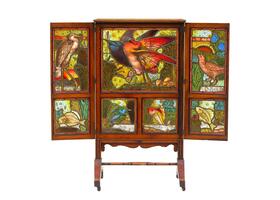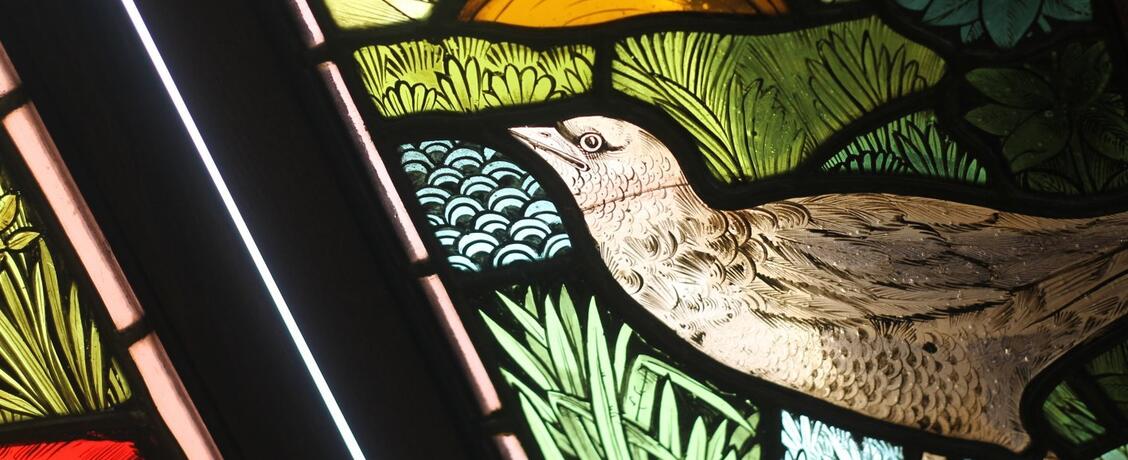Fire Screen That Bridges Two Late 19thC Artistic Movements
Fire Screen That Bridges Two Late 19thC Artistic Movements
by Rosei Frost
The Arts & Crafts Movement has enjoyed popularity since it began in the late 19thC. Formed as a reactionary movement against mass production its core beliefs were rooted in a revival of traditional construction methods, it has maintained a celebrity status into the 21stC. The Aesthetic Movement has not enjoyed the same prestige and in comparison, is not as widely known or recognised despite being the precursor to many Arts & Crafts ideals.
The Aesthetic Movement- ‘Art for Art’s Sake’ 1860-1900
The Aesthetic Movement was centred around the idea of beauty at any cost and a devotion to ensuring this could be achieved in the home by careful following rules on ornamentation with a particular focus on connoisseurship. Home instruction manuals became bibles of how to decorate your home and keep up with modern design trends. These forerunners to our modern interior magazines directed the fashionable middle-classes on which wallpaper, furniture and objects to buy that would elevate their status as artistic aficionados. The industrialisation of Victorian Britain allowed many access to affordable mass produced home wares that reflected these modern tastes.
Possibly due to this air of ‘superiority’ Aesthetes, (and their interpretation of what constituted beauty), became widely mocked. There are numerous examples of this from contemporary newspapers and Royal Worcester even produced caricature teapots featuring a man wearing a sunflower on one side and the female side sporting a lily (motifs of the aesthetic movement). Famous aesthetes include Oscar Wilde, Edward Burne-Jones, William Morris and Dante Gabriel Rosetti. Designers include Christopher Dresser and E.W Godwin.
Arts & Crafts Movement 1860-1910
The Arts & Crafts Movement reacted against mass production and industrialisation. They were not pre-occupied with ‘beauty’ as the aesthetes before them had been or attempting to dictate how people should decorate their homes but to showcase the talents of crafts people and the using natural materials to craft objects. William Morris influenced many designers from the Movement, and he eventually joined the Arts and Crafts Exhibition Society in 1891 until his death in 1896. He passionately advocated for small- scale workshops producing not only beautiful objects, but well-made ones. Many members of the arts and crafts movement were trained architects meaning there was a greater emphasis on the exterior of buildings as well as interior objects. This was reflected in a wide range of design elements, from furniture to textiles, metal wares to jewellery.
Many of their ideals were based on notions of rural life and traditions being revived. It is often obvious to see how an Arts and Crafts object has been made, the visible rivets, the hammering marks on silver, clever joinery. These provided a link from the person who created the object to the consumer. Figures associated with the Arts & Crafts Movement; William Morris, Augustus Pugin and John Ruskin.
The next Special Sale on the 30th May has an exceptional fire screen that combines elements of both these artistic movements. The screen is constructed from seven panels of stained glass depicting three birds and four fish. The main image shows two birds taking flight, one depicted in darker colours overlayed by another in reds and yellow. Storks and cranes were motifs frequently used by adopters of the Aesthetic Movement. From 1603-1867 Japan had closed its borders to most foreign trade. The restrictive foreign policy was known as Sakoku and the opening of the borders in 1867 had a huge impact on English interior design meaning there was an appetite for anything Japanese. In the art world this craze was known as Japonisme.
The stained glass is at its heart an Arts and Crafts element. Beautiful hand decorated glass that has been skilfully leaded together to reflect the historical tradition of an ancient craft. The stylised birds and fish move away from the religious scenes traditionally associated with this method of glass decoration and made it relevant to the interiors of the late 19th/ early 20thC. Its method of construction embodies the Arts and Crafts ideology, and the decoration showcases the Aesthetic Movement’s belief that art should be consumed simply for its pure beauty. Guided at £500-800 it offers a chance to own an object that bridges two key artistic movements.
The Special Antiques Sale, 30th May at TW Gaze Diss Auction Rooms. www.twgaze.co.uk for more details.

